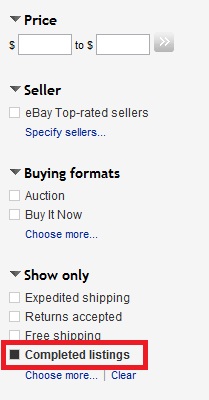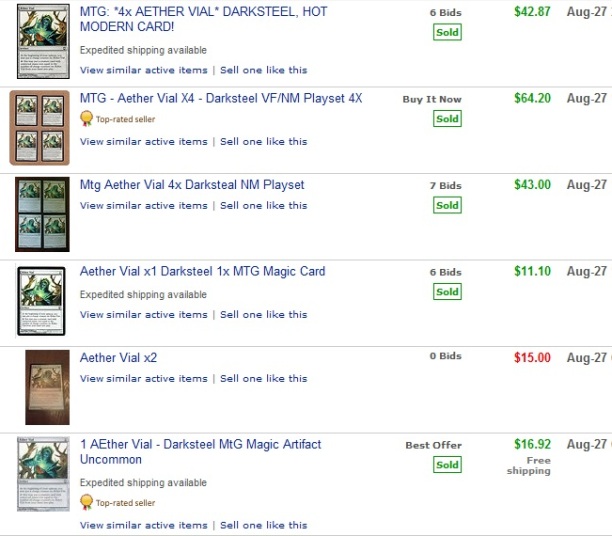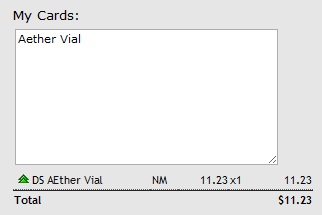In this column, we talk about acquiring cards, but we rarely go over the other side of the equation. What do we do with the cards after we buy or trade
for them? There are a lot of different places that you can sell your cards like eBay, www.magictraders.com
(MOTL), and dealers. You can even put price tags on the cards inside your binder and sell them that way. Finding an outlet to sell your cards is the
easy part. If finding an outlet was all there was to it, then we would have a lot more people selling Magic cards. The truth is that there is a host of
skills that are needed to be successful in selling cards. One of the most important of these skills is understanding pricing.
For the purposes of this article, we will talk about pricing from the perspective of selling a card. It’s important to make the differentiation
between pricing a card to sell it and valuing a card in a trade. Valuing a card in a trade is all about finding a common language to make a deal, and
pricing to sell is about finding the right balance between positioning and profit.
Pricing is the lifeblood of any successful dealer. The price that you sell a card for often dictates the price that you buy a card for. This makes
pricing an integral part of the whole process. If you price a card too low, then you leave money on the table; if you price it too high, then you tie
money up in inventory and suffocate your cash flow.
Last year, a friend of mine wanted to start selling stuff on MOTL. He put his sale list up and waited for the money to start rolling in. Much to his
dismay, his sale list was generating very little interest. He asked me to look at his list and see if he could format it better to make more sales.
Once I got to the list, I immediately realized the issue with his list. His pricing was totally off. I asked him, “Where did you get these prices
from!?” He said, “I’m charging less than eBay.” Something seemed off, so I did some research. It turned out that he was selling
cards less than the “Buy it now” (BIN) auctions.
need to look at the closed auctions. Let’s take a quick field trip, and I’ll show you how to check closed auctions. Log into eBay and do a
search on your favorite Magic cards. Then on the far left, follow the column down until you see the “Completed Listings” check box. Check
that box, and BAM you’re in business.

I went through his sales list and re-priced all his cards. The next day, they started flying off the shelf. You might ask, “Couldn’t you
have just lowered the prices to get the same result?” The problem with just lowering the price is that you’re not basing your price on
anything; instead you’re just lowering it in hopes that you might hit the sweet spot and sell the card. You could just keep lowering it until you
find a price that sells, but why spend the extra time doing that when you can see on average what people are paying for the card and make an educated
decision from the beginning?
The other reason that looking at eBay closed auctions is important is that it gives you leverage in negotiation. You can always just send the potential
buyer the closed auction links and say that you’re pretty sure that you’re going to get your asking price. It’s important that all your pricing
is attached to actual data; it keeps your business healthy, and it’s more stable than just trying to free roll wins with high prices that somehow get
there.
Alright enough talk; let’s get down to the nitty-gritty. We can talk about pricing on the way through our little adventure.
Let’s pretend that you want to sell some cards on MOTL.
Phyrexian Metamorph Foil NPH
Aether Vial
I picked a couple of cards so that we can talk about different aspects of pricing. For each card, I’m going to go through my pricing method and
show you exactly how I would price the card and why.
Phyrexian Metamorph Foil NPH
I wanted to throw you a curveball with this card. The key thing to understand about pricing this card is that it’s a foil. Foils are rarer that
non-foils. I know that’s obvious, but what it means is that you can charge close to retail because the supply for foils is typically lower than
non-foil. Before we go further, let’s expound on what I just said, specifically the use of the word “retail.”
In pricing you basically have three levels that are relevant: retail, eBay, and buy list pricing.
Retail
– This is the typically the highest that you can hope to get for a card. For the purpose of the article, I’m going to focus on online
retailers. If we were talking about the full scale of pricing, then brick and mortar would be its own level of retail pricing, but if you want a price
that is compatible with online markets as well as real-life markets, then the “online price” is a better measure because real-life prices
can be too high for online markets.
Sites to Check: www.starcitygames.com, www.findmagiccards.com
eBay
– This is where most of us live. Let’s face it; it’s rare that we will get Star City prices for the cards that we sell. There’s
nothing wrong with that. We don’t offer the same service as Star City Games, and we don’t have the reputation or the infrastructure to
demand the retail price for cards. The unique thing about eBay is that there are some auctions that close at ridiculous prices. You know the kind.
It’s the auction where the kid stayed up until 3:50 in the morning and scored a $32 NM Tropical Island. Does this mean that we should sell
Tropical Islands at $32? Obviously not! Instead we use the average eBay closed auction pricing.
You can calculate this yourself by looking at the recent closed auction and calculating the average (we will go over this in a moment) or you can use a
website (Apathy House) that calculates it for you. The problem with using a website to calculate it for you is that you have to use the parameters that
are built into their process. This means that if there is a spike on eBay, then these websites often don’t reflect it until the data is refreshed
(this could be weeks).
Sites to Check:
www.ebay.com, www.apathyhouse.com/pricelist/trader.php
Buy List Pricing
– This should be considered the bottom line for card pricing; there is no reason to sell cards for less than dealers are buying them for. Dealers
are part of the trader’s network of resources, and all sales to dealers should be motivated by a plan. For example, if you buy a collection and
you got an extra box of common/uncommons with it. If the box has things like Dark Rituals and stuff, then you can collect a little cash and save
yourself the time of grinding the box. Or let’s say that a dealer posts insane buy prices for all the staples in a new format. It might be best
to sell out to them before the bubble bursts. The only reason to sell cards cheaper that what it’s listed for on a buy list is if you are already
on the “dealer sell plan,” and the card is in less than NM condition.
Sites to Check:
sales.starcitygames.com/buylist/
Alright, that was a nice detour; let’s get back to pricing this foil Metamorph. The first place to look is to check the retail price.
Retail
Star City Games – $12.99
Find Magic Cards – $12.50
As a side note, I typically choose the lowest price on Find Magic Cards when dealing with both foils and non-foils. This makes sense because in theory,
my customers could buy the cards at these prices, so the lowest price is the most relevant for figuring out a baseline.

eBay
eBay – $6.99 -$12.99 ($9.16 Avg.)


To get the average here, all you need to do is add up the total of all Metamorphs. In this case, it’s $54.98. Then divide it by the sample size, which
is six. This gives you the average eBay price of $9.16. Keep in mind that this is really loose math; you don’t want to use this style of math if
you are calculating fuel measurement for launching a space shuttle.
You might notice that I didn’t use Apathy House for figuring out this price. Apathy House is great for non-foils because there’s more data
for their process to work with, but it’s terrible for foils because oftentimes the data isn’t there. There’s also an issue with
Apathy House calculating the price of promos with the price of set foils. If you checked, Apathy House you would see this at work. It has foil
Metamorph at $5.87, which is lower than the Star City Games buy price.
Buy List
Star City Games – $6
Now that we know everything there is to know about foil Phyrexian Metamorph, the only thing left to do is figure out our listing price. We know that we
don’t want to sell it for less than $6, and if we are interested in selling it, we shouldn’t list it at $12.50 or more because you have to
consider that your customer knows their options. If you list it at the eBay average price ($9), this would for sure be a slam dunk for selling the card
because it expands your market beyond consumers to brick and mortar or other shops to buy it and resell it at a margin. Like I said above, you can list
this card at closer to retail than non-foil cards because there are fewer on the market, and there’s less of a chance that a customer is going to
find a deal.
What I would do is list this card at $11. I am not interested in selling it to vendors or marketing it to that group of people because there is a
strong market for foils, and at $11, my price beats other retail prices. Let’s look Aether Vial.
Aether Vial
This card has seen a little bump because of Modern hype. Let’s look at some real data to see what we should be selling this for.
Retail
Star City Games – $14.99
Find Magic Cards – $13.95

Be sure to check the condition when looking at Find Magic Cards. You can get Aether Vials for $11.30, but the condition is VF. This is not a good
pricing anchor to go by when you’re trying to sell a NM Aether Vial.
eBay
eBay – $10.72 -$16.92 ($12.72 Avg.)

Apathy House – $11.23

Buy List
Star City Games – $6
Based on the research we did, it looks like the fire sale price for an Aether Vial is $11, and the price that I would shoot for is $13.
Closing Thoughts
I hope these exercises gave you a taste of what’s involved in pricing a card. When you combine these methods with profit margin targets, it
allows you to figure out how much you can buy a card for and still hit your target profit margin.
The topic of pricing is a deep one; this is only an introduction. There are other facets of pricing that I would like to cover in this column, such as
positional pricing, when you position yourself in a market with a certain price or pricing physiology, when to lower a price, and how raising a price
affects the sale. If you would like to hear more on this stuff, sound off in the comments. Before I get outta here, I will leave you with the buzz from
Pittsburgh.
Hotlist
Elspeth, Knight-Errant $14.99
– I was asked about this card quite a bit. It’s one of the more powerful planeswalkers in Modern. You should look into picking this up.
Amulet of Vigor $.75
– I have no idea why this was hot, but people were asking for them all day. Was it a case of group think or an information leak? I don’t
know, but keep an eye on this card.
Thanks for reading!
Jonathan
